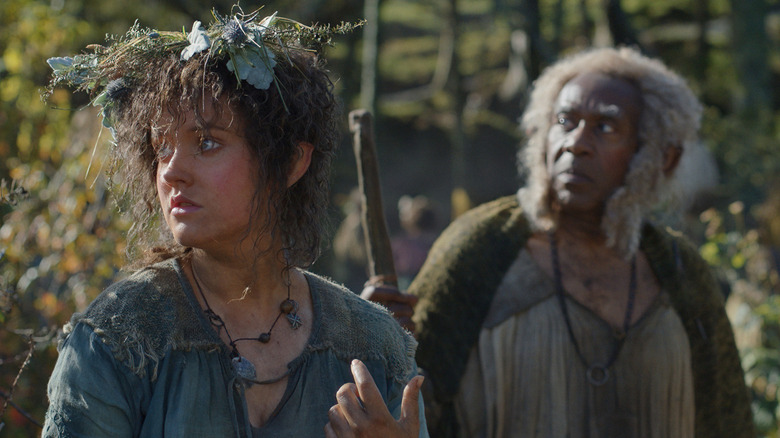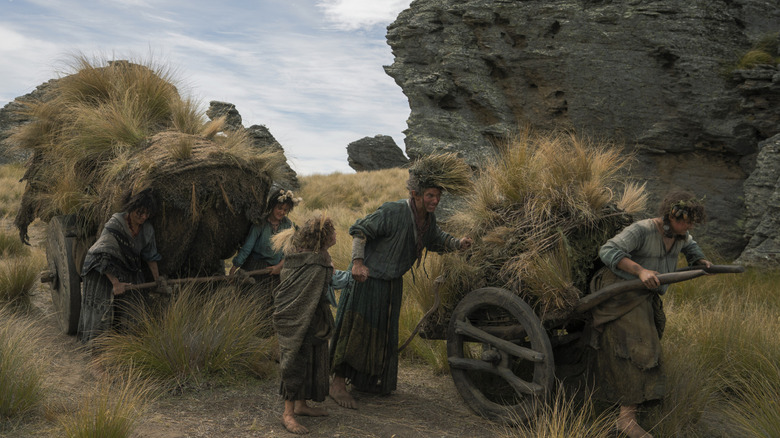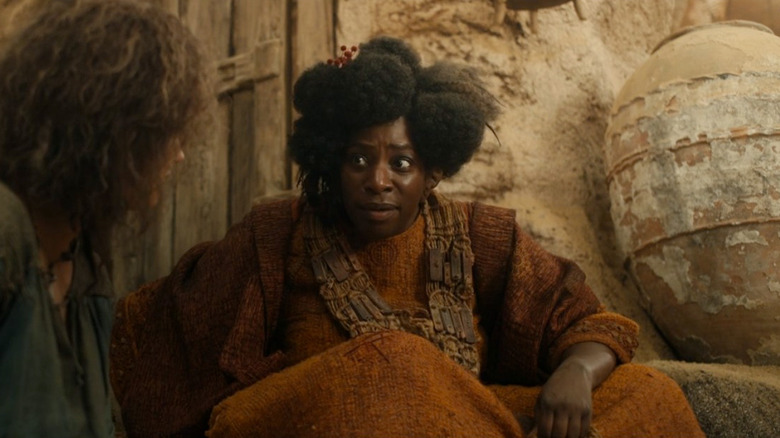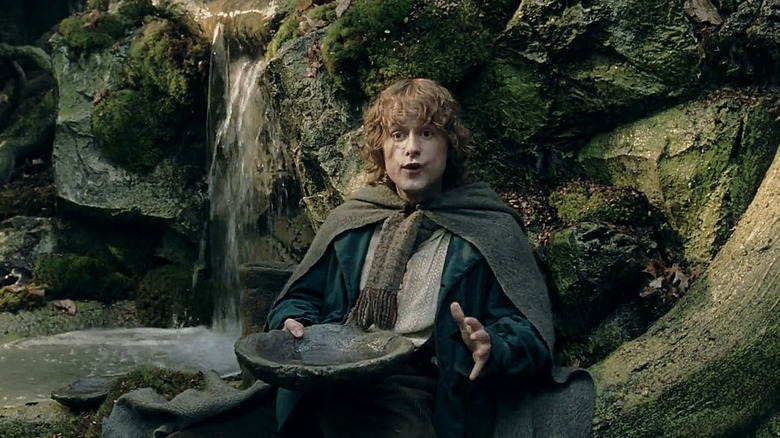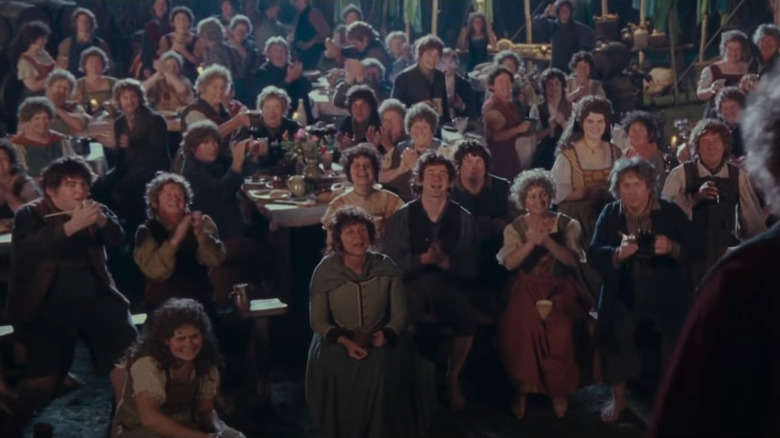The Lord Of The Rings: Are Harfoots Hobbits?
Hobbits are synonymous with Middle-earth. They are the half-pint heroes of "The Lord of the Rings," while "The Hobbit" is literally named after one of them. But when it comes to earlier stories from J.R.R. Tolkien's world, Hobbits don't show up. The earliest iteration we get of the Halflings is in Prime Video's "The Lord of the Rings: The Rings of Power" series, and even then, they're called Harfoots, not Hobbits.
So, are Harfoots Hobbits, then? Or are they something else? The answer, as is often the case with Tolkien's complex and nuanced world, is both. Part of the answer is the semantics of it all (an area that the Oxford professor loved). Technically, you can say yes, Harfoots are Hobbits. However, not all Hobbits are Harfoots. This is because the Harfoots are one of three Halfling "groups" that eventually coalesce to create the Hobbits we know and love from "The Lord of the Rings."
The prologue to "The Fellowship of the Ring" explains that early in the Third Age, the Hobbit ancestors live further east, but over time, they migrate westward. The passage also states, "Before the crossing of the [Misty Mountains] the Hobbits had already become divided into three somewhat different breeds: Harfoots, Stoors, and Fallohides." So by the time Harfoots are a thing, the term "Hobbit" is also in use, with a Harfoot considered distinct from one of the other two main ancestral branches of the Hobbit family tree. So if a being is called a Hobbit, they might also be a Harfoot — or they could be a Stoor or a Fallohide. Make sense? Good.
Who are the Harfoots?
When it comes to the Harfoots being ancestors of the Hobbits, "The Rings of Power" and J.R.R. Tolkien's own writings line up. However, the adapted and original versions don't concur on all points. The biggest change is timing: In the show, the Harfoot storyline is playing out in the Second Age, a time when Tolkien explained that recorded Hobbit history doesn't exist yet.
That doesn't mean the Hobbits themselves don't exist, though. On the contrary, the "Fellowship of the Ring" prologue clarifies that Hobbits are a very ancient people who have been quietly puttering around Middle-earth since the Elder Days, a period of Middle-earth history that pre-dates the Second Age. So it's completely reasonable to have some kind of Hobbits wandering around in the Second Age. Hence, the Harfoots.
As far as looks are concerned, Tolkien describes the Harfoots as "browner of skin, smaller, and shorter, and they were beardless and bootless; their hands and feet were neat and nimble; and they preferred highland and hillsides." Overall, the description of the Harfoots lines up with the Hobbit ancestors Tolkien wrote about in the Third Age.
"The Rings of Power" Harfoots are a down-to-earth, timid community, in typical Hobbit style, but they're also a forward-thinking group who are ahead of their relatives in at least one respect: their westward migration. When the show starts, they are already living farther west than the Stoors. This also resonates with the book, which says that later on in Middle-earth history, they are the first of the three groups to cross the Misty Mountains. As far as other non-canonical points, in the show, the Harfoots host the non-book-accurate arrival of the Stranger — who was confirmed as Gandalf in the Season 2 finale – and live in areas populated by Men (in the books, they are more connected with Dwarves).
Who are the Stoors?
The other Hobbit sub-group we meet in "The Rings of Power" Season 2 is the Stoors. This is the distant Eastern enclave that lives in Rhûn, which also featured heavily in the show's second season. The "Fellowship of the Ring" prologue describes this group as "broader, heavier in build; their feed and hands were larger; and they preferred flat lands and riversides." It adds that later in the Third Age, the Stoors "came west after the Harfoots" and were less shy of Men.
The Second Age version of the Stoors, as seen on the show, mirrors some of these attributes. They are generally more settled and industrious than the Harfoots, and they live in communication with the nearby Men of Rhûn. Their desert living conditions are a fun polar opposite from their water-loving Third Age future, too.
It's also worth noting that while the Harfoots are led by Sadoc Burrows (Lenny Henry) in Season 1, the Stoor community leader is Gundabel (Tanya Moodie). This female-forward leadership reflects the background of the most famous Stoor in all of Tolkien's writings: Gollum. That's right: Gollum, aka Sméagol, was not just a Hobbit once but an ancestor of the Stoors. Later in "The Fellowship of the Ring," Gandalf explains to Frodo that Gollum's original community "were of hobbit-kind; akin to the fathers of the fathers of the Stoors." The Wizard also adds that this critical character from "The Lord of the Rings" comes from a wealthy family, saying, "[It] was ruled by a grandmother of the folk, stern and wise in old lore, such as they had." Sound familiar? Gundabel fits the mold of a Stoor matriarch perfectly.
Who are the Fallohides?
This leaves the Fallohides, the third proto-Hobbit group and the only one not to grace the streaming screen through Prime Video's show (as of Season 2). The "Fellowship of the Ring" prologue describes this group by saying, "The Fallohides were fairer of skin and also of hair, and they were taller and slimmer than the others; they were lovers of trees and of woodlands."
The text adds that there are fewer Fallohides, they are located further north than the other groups, and they are friendly with Elves. They are hunters, craftspeople, and experts with language. They are also the most adventurous of the Hobbit breeds and are the ancestors of famous families of leaders like the Tooks (who are related not just to Pippin but to Frodo, Merry, and Bilbo).
Since Season 1 of "The Rings of Power" gave us the Harfoots and Season 2 introduced the Stoors, it would make sense for showrunners JD Payne and Patrick McKay to bring the Fallohides into the mix in the coming season. Remember, Season 2 ended with Nori (Markella Kavenagh) and Poppy (Megan Richards) leading the Stoors west out of Rhûn, toward greener pastures and forested regions — the kind of areas Fallohides might be located in.
Will we see full-blown Hobbits in The Rings of Power?
Will Hobbits as most people know them show up in "The Rings of Power"? Technically, we've already seen them, albeit specific branches of their culture. However, there's a chance that we'll see the three groups combine into the Hobbit community of the Third Age and settle in the Shire before the show ends.
Yes, this would probably clash with the author's original chronology, but the showrunners have already shown that they're not afraid to mess with the Tolkien timeline. They already changed the order of the forging of the Rings of Power, had the Balrog wake up thousands of years too early in Moria, and have Gandalf bopping around Second Age Rhûn (all of which are dramatic departures from or additions to the source material). Heck, they've also deviated from the chronology in an even bigger way by condensing all of the events of the 3,500-year-long Second Age into a single point in time.
If they're already comfortable making these changes, they could clearly bend some canonical truths to get their Hobbit storyline to fit. In Tolkien's writings, the three groups combine to create the Hobbits early in the Third Age, before settling the Shire halfway through that era — hundreds of years before the Balrog is even supposed to wake up in Moria. Considering the fact that the fiery demon is already alive and kicking in the show, it's not unreasonable to expect JD Payne, Patrick McKay, and company to have Nori and Poppy fearlessly unite the three branches of the Hobbit extended family, cross the Misty Mountains, and settle the Shire before this thing comes to a close.
